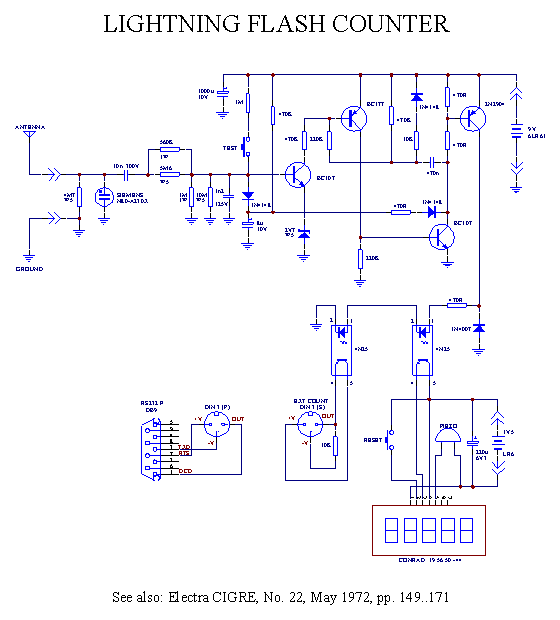
(Click to enlarge)


The circuit of this device is quite simple: an input circuit filters the
signal provided by the antenna to reduce sensibility to other phenomena and
protects against over voltages. The four transistors realize a "one-shot"
section that is triggered by the input circuit and provides pulses of about
0.05 seconds to the counter (the 470 nF capacitor set this time). When the
one-shot is triggered it cannot be retriggered for about one second (imposed
by the 8 uF polarized capacitor) to avoid multiple counts for the same
strike.
This part is powered by a 6LR61 9 V cell and, since the power consummation is
lower than 1 uA (when no strikes are detected) a single cell will last for
some years. The test button allows to check if the battery is still
operational: each time it's pressed the counter should increment and, if hold
down, the counter should increment about once per second.
The two optocouplers interface the output of the one-shot circuit with the
real counter and with the PC. I used a digital 5-digits LCD counter powered by
a LR6 (AA) 1.5 V cell. The power consummation of this counter is about 1.5 uA
and the battery life is about one year. This counter also has a reset switch
and a piezo speaker that beeps on every operation. Any other counter should
work fine (even mechanical ones) but the interface must be modified. The
insulation between the counter and the one-shot provided by the optocoupler
here is not necessary: I just used an optocoupler to adapt the two different
voltages (9 V and 1.5 V). A 6-9 V DC counter can be directly connected between
the collector of the 2N2904 ant the ground.
The other optocoupler interfaces this circuit with a PC via an RS232 serial
port. Here the insulation is necessary.
This circuit is not critical and every semiconductor can be replaced with a similar one. The input circuit uses power resistors and high voltage capacitors: it must be well insulated. For better accuracy the input circuit should use 1% precision parts.
The whole circuit must be mounted in a grounded metallic box.


| Back to the index. | 
| Back to the home page. |

| Previous page. | 
| Next page. |


| Questa pagina è disponibile anche in italiano. |
